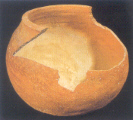>From this same period of time a settlement has been found in Kalba and a tomb in Al Suffouh. After that there is a gap in our
present-day knowledge, because very little evidence was found dating back to the second millennium BC. Then starts the Iron age (1st Mill. BC) and many settlements were thriving: a caravansary in Hili, a
village near Al Tuqaibah, a fort with an urban settlement at Milaiha, graves at Jebel Buhays, sulfur mines at Jebel Dhana, tombs at Bithnah, Qidfa and Husn Madhab and a prosperous community at Kush near Ras
al Khaymah. The Kush occupation continued from the first Mill. BC till the early Islamic era.
 Mileiha is the only know site with occupational evidence from the
late 3rd C. BC till the 3rd C. AD, partly contemporary with the occupations at Ad Door and Kush.
Mileiha is the only know site with occupational evidence from the
late 3rd C. BC till the 3rd C. AD, partly contemporary with the occupations at Ad Door and Kush.
This site has yielded a treasure of constructions and artefacts.
The most obvious structure is a 2000 meters square fort with 2m thick walls that stretched for 55 meters, with towers on each corner and midway along each wall, eight in all. The building was
not only used for defence and protection but also as a residence, judging from the presence of storerooms with large storage jars and Mediterranean amphoras (some
with Latin inscriptions), grinding stones and what seems to be the country's one and only prehistoric minting facility. This was located in a room that had many small
fireplaces with lots of copper slag, where the copper was melted to makes bronze coins. Coin moulds were also found. Sixty-four coins minted here can be seen at the Sharjah Museum.
Another interesting feature of the Mileiha dig is the evidence of camel burials. Important people were buried with their beast of burden slaughtered near their tomb.
In one case a horse was also found, complete with a pure gold head ornament. This artefact can be seen in the Sharjah archaeological museum in a stunning display with
a re-enacted film of Mileihan warriors, one riding the horse wearing the headdress at great speed through the desert.
Only a few pre-Islamic sites have been described so far. The fort of Mileiha was
constructed in this period. On Sir Bani Yas an interesting find was made a few years ago: that of a Christian monastery dating from the 5th to 8th C. AD. Several
exquisite plaster decorations in raised relief were uncovered: of floral designs, of a Nestorian cross and other geometric designs.
The occupation at Kush continued from the Iron Age till the early Islamic era. In Jumeirah there is also an early Islamic site that is still being studied.
Of the more recent past - the late Islamic era - there is much evidence: the extension of Abu Dhabi airport had to be delayed for quite a while to allow the rescue
dig of such a site. On Abu al Abyad Island and in Julfar near Ras al Khaymah other occupations from this time were studied. Julfar is especially interesting as a historic
Islamic seaport. It has been under excavation since 1989. The site was occupied from the early Islamic days till the late 17th C. AD. The 1991 excavations uncovered
evidence of three mosques built one on top of the other.
